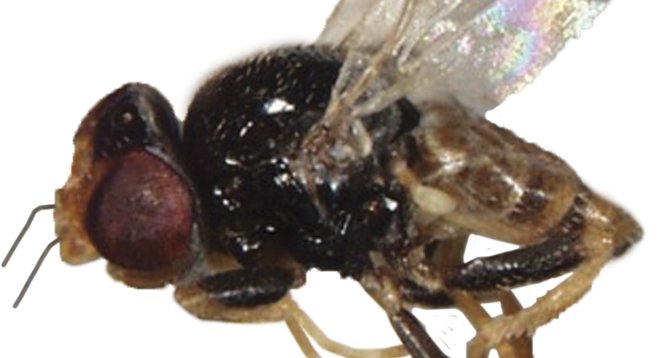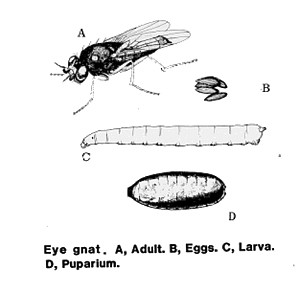 Facebook
Facebook
 X
X
 Instagram
Instagram
 TikTok
TikTok
 Youtube
Youtube

Organic foods are about 2 percent of world food sales but are growing at 20 percent annually. They are produced without use of synthetic pesticides, chemical fertilizers, solvents, or additives. Although they may cost at least 40 percent more than nonorganic foods, they are loved by environment-friendly consumers, who claim, among many things, that these foods mitigate the greenhouse effect and are healthier.
But in San Diego County, organic foods face a tiny bit of a roadblock: the eye gnat, a shiny, nonbiting black fly only 1/16 of an inch in size. These pesky gnats are found in the Southwest, particular California and Arizona. They swarm in folks’ eyes and noses — more noisome, often, than the proverbial skunk at the garden party.
Indeed, residents in southern Escondido have claimed in recent years that they have been driven indoors by these vexatious mini-flies. Golfers at the Vineyard course have bitched, too.
Early this year, more than 300 southern Escondido residents crowded into an elementary school to hear the County’s plan to abate the problem. Dr. Lawrence Michel, who lives in the area, stated at that time that beginning five years earlier, the level of eye gnats had begun escalating. Particularly in hot summer months, “We couldn’t be out in our yards without getting a face full of eye gnats. Outdoor activities ceased — no barbecues, no outdoor parties.”

After some study, a large part of the problem was traced to an organic vegetable farm, Be Wise Ranch, on San Pasqual Road. Because organic farms don’t use pesticides, the gnats can breed. The County made several studies, as did Bill Brammer, who owns the ranch.
Brammer set about doing something. “The complaints about eye gnats aren’t false but are exaggerated,” he says. “I put 2000 traps on my property and 45 or 50 traps offsite,” such as in neighbors’ yards. He has set up 13,000 feet of silt fence to prevent gnat migration. “Researchers found a major cause of eye gnats was the way we grew tomatoes. We changed that by growing them on plastic. With the plant going through the plastic, there is no way for insects to reproduce.”
He says he has eliminated 98 percent of the eye gnat problem. And there is no doubt there has been dramatic improvement. The gnat nuisance “has definitely improved, although [gnats] have not completely gone away,” says Dominic Malcangio, event manager at the Vineyard.
Southern Escondido eye gnat complaints to the County have dropped sharply. Last year, for the three weeks in late June to early July, there were 80 complaints. For the similar period this year, there were only 2.
“There has been a noticeable improvement in eye gnat activity,” says Dr. Michel, who had complained so bitterly in earlier years.
Despite the improvement, the County board of supervisors intends to vote next month on a plan to crack down on Be Wise and possibly on other organic farms, which account for 16 percent of fruit and vegetable crop farmland in the county.
The ordinance would give the Department of Environmental Health latitude to tackle eye gnat nuisances when citizens complain. Farmers would have to follow a progressive strategy to eliminate the problem. As a last resort, the department could force the farmer to use pesticides on crops or fields. Then the farm would no longer produce organic foods.
Brammer says the ordinance’s requirements could cost him $500,000 a year, and he would lose $2500 for every acre he farms. “That would put me out of business,” he says. Now he is spending $100,000 a year controlling eye gnats. “I couldn’t survive if I could not be organic,” he says. He sells his produce to retailers such as Whole Foods, Trader Joe’s, Jimbo’s, and the Ocean Beach People’s Organic Food Co-op.
“The County is trying to drive organic farming out,” says Brammer, noting that under the ordinance, the County could respond to any citizen complaints against a grower. He hired Oakland-based Krout & Associates, a sustainability consulting firm, which reported, “Implementation of the proposed project and corresponding measure to apply pesticides has the potential to eliminate all organic farming in San Diego County.”
Although Dr. Michel has seen improvement, he says, “It is critical that the ordinance be passed. If things continue as they are, I think most, if not all, of the residents would be satisfied.” But that depends on Be Wise not dropping the ball. “Without the ordinance there is no penalty for not doing these things, and the eye gnat problem will come back. The ordinance should allow the County to inspect the farm at any time to verify compliance.”
Brammer “needs to know there is a stiff penalty if he fails to comply with abatement procedure,” says Michel. “For so long, Brammer denied being the source of the problem, and the only reason he started mitigating was when the County started talking about an ordinance. Otherwise, he wasn’t going to do anything.” Brammer says he wasn’t sure he was contributing to the problem until last year.
Eric Larson, executive director of the San Diego County Farm Bureau, objects to the most stringent part of the County’s plan. If the ordinance passes, “the farmer moves to mechanical measures to knock down the eye gnat population; should the problem continue, then the County can mandate use of pesticides. Farms would no longer be organic. We don’t buy into that last step.”
While this controversy raged in southern Escondido, citizens of Jacumba were also assaulted by eye gnats bred at an organic vegetable farm.
The farm was shut down (for nongnat reasons), but “the County continued to receive some eye gnat complaints after the farm closed,” says Michael Drake of the County’s Land Use and Environment Group. He concedes that San Diegans will always be bugged by some eye gnats, no matter how many measures are taken against farmers. ■


Organic foods are about 2 percent of world food sales but are growing at 20 percent annually. They are produced without use of synthetic pesticides, chemical fertilizers, solvents, or additives. Although they may cost at least 40 percent more than nonorganic foods, they are loved by environment-friendly consumers, who claim, among many things, that these foods mitigate the greenhouse effect and are healthier.
But in San Diego County, organic foods face a tiny bit of a roadblock: the eye gnat, a shiny, nonbiting black fly only 1/16 of an inch in size. These pesky gnats are found in the Southwest, particular California and Arizona. They swarm in folks’ eyes and noses — more noisome, often, than the proverbial skunk at the garden party.
Indeed, residents in southern Escondido have claimed in recent years that they have been driven indoors by these vexatious mini-flies. Golfers at the Vineyard course have bitched, too.
Early this year, more than 300 southern Escondido residents crowded into an elementary school to hear the County’s plan to abate the problem. Dr. Lawrence Michel, who lives in the area, stated at that time that beginning five years earlier, the level of eye gnats had begun escalating. Particularly in hot summer months, “We couldn’t be out in our yards without getting a face full of eye gnats. Outdoor activities ceased — no barbecues, no outdoor parties.”

After some study, a large part of the problem was traced to an organic vegetable farm, Be Wise Ranch, on San Pasqual Road. Because organic farms don’t use pesticides, the gnats can breed. The County made several studies, as did Bill Brammer, who owns the ranch.
Brammer set about doing something. “The complaints about eye gnats aren’t false but are exaggerated,” he says. “I put 2000 traps on my property and 45 or 50 traps offsite,” such as in neighbors’ yards. He has set up 13,000 feet of silt fence to prevent gnat migration. “Researchers found a major cause of eye gnats was the way we grew tomatoes. We changed that by growing them on plastic. With the plant going through the plastic, there is no way for insects to reproduce.”
He says he has eliminated 98 percent of the eye gnat problem. And there is no doubt there has been dramatic improvement. The gnat nuisance “has definitely improved, although [gnats] have not completely gone away,” says Dominic Malcangio, event manager at the Vineyard.
Southern Escondido eye gnat complaints to the County have dropped sharply. Last year, for the three weeks in late June to early July, there were 80 complaints. For the similar period this year, there were only 2.
“There has been a noticeable improvement in eye gnat activity,” says Dr. Michel, who had complained so bitterly in earlier years.
Despite the improvement, the County board of supervisors intends to vote next month on a plan to crack down on Be Wise and possibly on other organic farms, which account for 16 percent of fruit and vegetable crop farmland in the county.
The ordinance would give the Department of Environmental Health latitude to tackle eye gnat nuisances when citizens complain. Farmers would have to follow a progressive strategy to eliminate the problem. As a last resort, the department could force the farmer to use pesticides on crops or fields. Then the farm would no longer produce organic foods.
Brammer says the ordinance’s requirements could cost him $500,000 a year, and he would lose $2500 for every acre he farms. “That would put me out of business,” he says. Now he is spending $100,000 a year controlling eye gnats. “I couldn’t survive if I could not be organic,” he says. He sells his produce to retailers such as Whole Foods, Trader Joe’s, Jimbo’s, and the Ocean Beach People’s Organic Food Co-op.
“The County is trying to drive organic farming out,” says Brammer, noting that under the ordinance, the County could respond to any citizen complaints against a grower. He hired Oakland-based Krout & Associates, a sustainability consulting firm, which reported, “Implementation of the proposed project and corresponding measure to apply pesticides has the potential to eliminate all organic farming in San Diego County.”
Although Dr. Michel has seen improvement, he says, “It is critical that the ordinance be passed. If things continue as they are, I think most, if not all, of the residents would be satisfied.” But that depends on Be Wise not dropping the ball. “Without the ordinance there is no penalty for not doing these things, and the eye gnat problem will come back. The ordinance should allow the County to inspect the farm at any time to verify compliance.”
Brammer “needs to know there is a stiff penalty if he fails to comply with abatement procedure,” says Michel. “For so long, Brammer denied being the source of the problem, and the only reason he started mitigating was when the County started talking about an ordinance. Otherwise, he wasn’t going to do anything.” Brammer says he wasn’t sure he was contributing to the problem until last year.
Eric Larson, executive director of the San Diego County Farm Bureau, objects to the most stringent part of the County’s plan. If the ordinance passes, “the farmer moves to mechanical measures to knock down the eye gnat population; should the problem continue, then the County can mandate use of pesticides. Farms would no longer be organic. We don’t buy into that last step.”
While this controversy raged in southern Escondido, citizens of Jacumba were also assaulted by eye gnats bred at an organic vegetable farm.
The farm was shut down (for nongnat reasons), but “the County continued to receive some eye gnat complaints after the farm closed,” says Michael Drake of the County’s Land Use and Environment Group. He concedes that San Diegans will always be bugged by some eye gnats, no matter how many measures are taken against farmers. ■
Comments